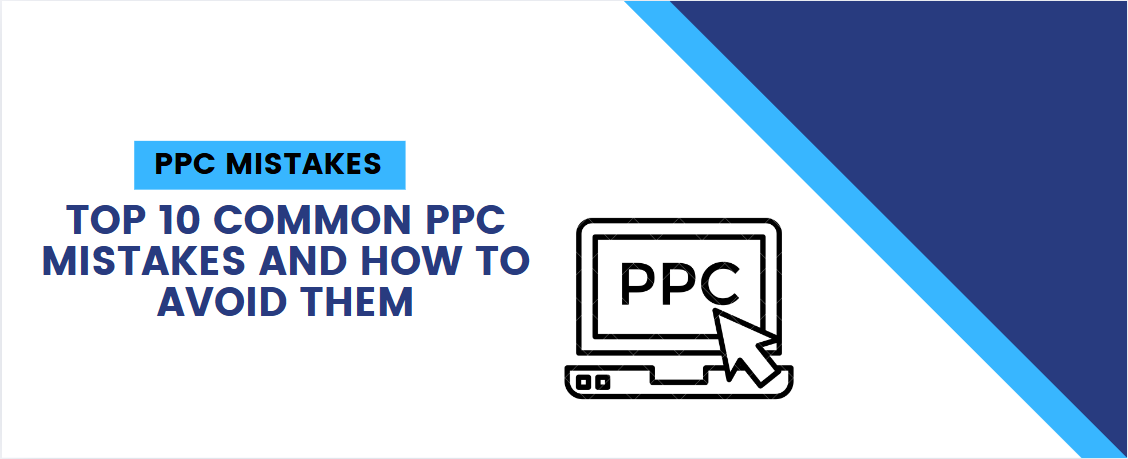Pay-Per-Click (PPC) advertising is one of the most powerful tools in digital marketing. When done right, it can drive targeted traffic, increase conversions, and boost ROI. However, even seasoned marketers can make costly mistakes that can waste ad spend and hurt performance. If you’re running PPC campaigns or planning to start, it’s crucial to understand what can go wrong and how to avoid it.
In this post, we’ll dive into the top 10 common PPC mistakes and how you can fix them to ensure your campaigns are more effective and efficient.
1. Not Defining Clear Goals
One of the most fundamental mistakes in PPC is not having clear, measurable goals. Without a solid objective, it’s almost impossible to gauge the effectiveness of your campaigns or know if you’re making the right decisions.

Common mistake: You launch campaigns without knowing exactly what you want to achieve. Is it more sales? Leads? Brand awareness? Each goal will require a different approach.
How to avoid it: Before you start any PPC campaign, define your goals clearly. Whether you’re looking to drive conversions, generate leads, or boost website traffic, having a goal in mind helps you choose the right ad types, targeting, and key performance indicators (KPIs).
Tip: Use the SMART goal framework (Specific, Measurable, Achievable, Relevant, Time-bound) to clarify your objectives. For example, “Increase sales by 20% over the next 3 months" is much clearer than just “Increase sales."
2. Ignoring Keyword Research
Effective keyword research is the foundation of any successful PPC campaign. Not putting enough effort into finding the right keywords can lead to wasted spend on irrelevant clicks, low conversion rates, and poor ad performance.

Common mistake: Running PPC campaigns with generic or broad keywords, or not properly segmenting your keyword list.
How to avoid it: Use tools like Google Keyword Planner, SEMrush, or Ahrefs to find highly relevant, high-intent keywords for your business. Group keywords by themes or categories (e.g., broad, exact match, long-tail), and focus on terms that are most likely to convert.
Tip: Don’t just focus on volume. Aim for keywords with a good balance of search volume and competition. Long-tail keywords may have lower search volume, but they are often more specific and can drive higher conversions.
3. Not Using Negative Keywords
Negative keywords are critical for refining your PPC targeting and ensuring your ads don’t show up for irrelevant searches. Failing to use negative keywords means your ads could be displayed to people who aren’t interested in your products or services, leading to wasted spend.

Common mistake: Letting irrelevant traffic come in because you’re not using negative keywords, or not updating your negative keyword list frequently.
How to avoid it: Regularly audit your campaigns and identify irrelevant searches that triggered your ads. Add those as negative keywords to filter out traffic that’s unlikely to convert. For example, if you’re running a campaign for high-end luxury watches, you might want to add “cheap” or “discount” as negative keywords.
Tip: Make negative keywords part of your routine campaign optimization. Check your search term reports regularly to see which queries are driving unqualified traffic.
4. Not Optimizing Landing Pages
Your PPC ad might be fantastic, but if the landing page is slow, irrelevant, or unappealing, users will bounce, and your conversion rate will suffer. A bad landing page will waste all the hard work you put into creating a great ad.
Common mistake: Sending clicks to a generic homepage or a poorly designed landing page that doesn’t match the intent of the ad.
How to avoid it: Make sure your landing page is directly relevant to your PPC ad. The messaging should align with the keywords and offer clear calls-to-action (CTAs). Additionally, ensure the page loads quickly, is mobile-friendly, and is optimized for conversions (e.g., easy-to-fill forms, clear navigation, trust signals).
Tip: Use tools like Google’s PageSpeed Insights or Hotjar to test the speed and performance of your landing page. A well-optimized landing page can drastically improve your Quality Score in Google Ads, lowering your cost per click.
5. Failing to Track Conversions Properly
If you’re not tracking conversions, you have no way of knowing whether your PPC campaigns are truly driving value. You might be spending money, but without the right data, you’ll never know if it’s paying off.

Common mistake: Not setting up conversion tracking or improperly tracking goals, such as sign-ups or purchases.
How to avoid it: Set up conversion tracking for every important action you want users to take—be it form submissions, downloads, sign-ups, or sales. Use Google Ads conversion tracking, or integrate Google Analytics to track detailed behavior on your site.
Tip: If you’re using e-commerce platforms, make sure you track transaction value (revenue) along with the number of conversions. This helps you tie your ad spend directly to revenue.
6. Not A/B Testing Ads and Landing Pages
Even if you’ve created a well-targeted PPC ad, that doesn’t mean it’s performing at its best. A/B testing (also known as split testing) is essential to continuously improve your ad copy, design, and landing page elements.

Common mistake: Not testing different versions of ads or landing pages, and relying on a single variation for all traffic.
How to avoid it: Regularly test variations of your ad copy, headlines, call-to-actions, images, and landing page elements. For instance, you might test one version of an ad that emphasizes “limited-time offers” against one that highlights “free shipping.” This will help you identify which combination performs best.
Tip: Use Google Optimize for A/B testing your landing pages, or use built-in A/B testing tools within your PPC platform. Even small changes in ad copy or CTAs can result in significant performance improvements.
7. Overlooking Mobile Optimization
With mobile traffic accounting for over 60% of web visits, not optimizing your PPC campaigns for mobile devices is a huge mistake. If your ads aren’t designed to appeal to mobile users, your conversion rates will drop significantly.

Common mistake: Creating PPC ads or landing pages that look good on desktop but don’t translate well to mobile screens.
How to avoid it: Ensure your landing pages are responsive and load quickly on mobile devices. For PPC ads, use mobile-preferred ads that cater specifically to smartphone users (e.g., shorter text, mobile-friendly CTAs, and location targeting). You should also adjust your bids to prioritize mobile traffic, as mobile users often have different behaviors than desktop users.
Tip: Google Ads allows you to view your campaigns’ mobile performance separately, so you can see how ads and landing pages perform across devices. If mobile conversion rates are lagging, consider increasing mobile bids or creating mobile-specific campaigns.
8. Ignoring Quality Score
Google Ads assigns a Quality Score to each of your ads based on the relevance of your keywords, ad copy, and landing page. A low Quality Score can increase your cost per click (CPC), making your campaigns more expensive.

Common mistake: Ignoring Quality Score factors and simply focusing on increasing bids to improve ad position.
How to avoid it: Aim to improve your Quality Score by ensuring your keywords, ad copy, and landing page content align closely. A well-targeted, relevant ad will lead to a higher Quality Score and lower CPC, which makes your campaigns more cost-effective.
Tip: Quality Score is based on three main factors—expected click-through rate (CTR), ad relevance, and landing page experience. Regularly review your campaigns and optimize them to align with these factors.
9. Setting and Forgetting Campaigns
PPC is not a “set it and forget it” marketing tactic. If you simply create campaigns and leave them running without regular monitoring and optimization, you’ll miss opportunities for improvement and waste money.
Common mistake: Letting campaigns run without monitoring performance or making adjustments as needed.
How to avoid it: Regularly review your campaigns and tweak them based on performance. Look at metrics like CTR, cost per conversion, and return on ad spend (ROAS) to identify areas that need improvement. For example, pause ads or keywords that aren’t performing well, or increase budgets for high-performing ads.
Tip: Set up automated rules or alerts in Google Ads to help you manage campaigns more efficiently. For example, you can set an alert if your cost per conversion exceeds a certain threshold.
10. Not Analyzing Competitor Activity
In competitive industries, your PPC strategy should also account for what your competitors are doing. Not keeping an eye on their campaigns can lead to missed opportunities to outperform them.
Common mistake: Not analyzing your competitors’ PPC campaigns or ad copy to learn from their strengths and weaknesses.
How to avoid it: Use tools like SpyFu, SEMrush, or Ahrefs to analyze competitor keywords, ad copy, and landing pages. This gives you insights into their strategies and helps you find gaps in the market that you can exploit.
Tip: Regularly check the auction insights in Google Ads to see how your ads are performing relative to your competitors in terms of ad rank, impression share, and more.
Final Thoughts
PPC can be incredibly effective, but only if you avoid these common mistakes. Whether it’s setting clear goals, doing proper keyword research, optimizing your landing pages, or regularly refining your campaigns, small adjustments can lead to big improvements in your PPC results.
By being proactive and attentive to these potential pitfalls, you can improve your PPC performance, reduce wasted ad spend, and achieve better ROI.


